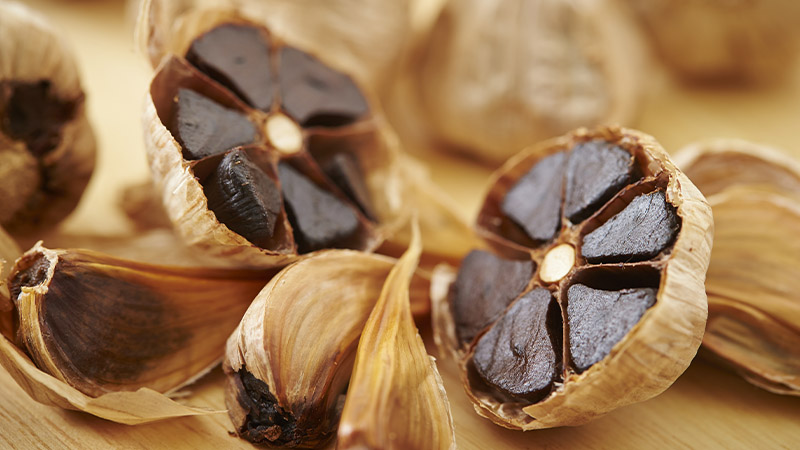What is it?
Black garlic is a type of fermented garlic popular in high-end cuisine in the West. In Asia, especially Korea, it is widely eaten for its health benefits.Whole bulbs of standard white garlic are fermented without additives at high temperatures for around three weeks, then left to cool for a further week. This process results in a bulb covered with brown, papery skin encasing black cloves. The standard 10-to-12 clove fermented garlic bulb is unrelated and differs in flavour from the six-clove naturally black garlic that grows in the Korean mountains.

The flavour
Black garlic is an interesting combination of smoky-sweet meets savoury, with tangy undertones of dark balsamic with a hint of garlic in the umami aftertaste. It has a tender, gelatinous texture, which melts in your mouth like stewed fruit or prunes.
Chefs have likened it to a liquorice wine gum, and it can be something of an acquired taste; mainly of interest because of its health properties and novelty value. Unlike raw white garlic, it has no acrid bite and does not leave you with bad breath.
Where to find it
Gourmet supermarkets and health food stores might have it, otherwise seek out your nearest Unity Pharmacy where it costs $68+ for a box of six garlic bulbs (yes, gourmet prices for this health-packed gourmet ingredient!).
Uses
- Eaten as-is by the health conscious in Korea, as a snack
- More recently, repackaged by global health brands as black garlic capsules or as an ingredient of health-giving energy drinks
- Used in high-end Western cuisine as a novelty garnish and flavouring
Health benefits
- Garlic in itself has many health benefits from its abundance of Vitamin C and other antioxidants. The ageing process for black garlic further enhances some of its benefits
- Korean researchers found that black garlic is loaded with nearly twice as many disease-fighting antioxidants as raw garlic
- Black garlic has more potent antibacterial and antiseptic properties than white garlic
Recipe
Black Garlic and Mushroom Risotto
Sometimes you need a decompression moment, to unwind after work or away from the kids. There’s something therapeutic about the paced stirring of risotto – aided with a chilled glass of crisp white – that is bound to help you reach a higher state of “Om”. In this hearty risotto recipe, the earthiness of the mushrooms and smokiness of the black garlic work extremely well together for a traditional Italian dish with a novelty Asian health boost.
Ingredients (serves 4)
- 1.5 litres vegetable stock
- 125g butter
- 4 tablespoons olive oil
- 1 onion, very finely chopped
- 2 stalks celery, finely chopped
- 1 carrot, finely chopped
- 2 peeled cloves white garlic, crushed
- 4 peeled cloves of black garlic, finely sliced
- 400g risotto rice
- 1 small glass white wine
- 4 large handfuls of mixed fresh mushrooms (try shiitake, girolle or chanterelle, Portobello, chestnut, oyster)
- 25g Parmesan cheese, freshly grated
- Juice of one lemon
- Freshly chopped parsley or thyme
- Salt and black pepper
Method
1. Slice or tear mushrooms, keeping some differing shapes or sizes for interest. Melt 50g of butter in a large frying pan with 2 tablespoons of olive oil (so the butter doesn’t burn). Add the mushrooms, white garlic and some salt and pepper and cook until browned. Set aside.
2. Heat 50g butter and 2 tablespoons of olive oil in the same pan. Add the finely chopped onion, celery and carrot and sweat them until soft. Mix in the black garlic.
3. Stir in the rice until it is well coated. Pour in the glass of white wine and allow the liquid to reduce, stirring continuously.
4. Add a ladleful of vegetable stock, continuing to stir. As soon as the liquid is absorbed, add another ladleful of stock and repeat until the rice is plump and cooked al dente, meaning soft but with a bit of bite.
5. When you are happy with the consistency, which should be creamy and oozy (add a bit more stock if it’s too dry), stir in the mushrooms and add the Parmesan cheese, the remaining 25g of butter, the lemon juice and a drizzle of extra virgin olive oil. Garnish with parsley or thyme.
We hope you found this interesting; click here if you’d like to read more.
Don't miss out on the latest events, news and
competitions by signing up to our newsletter!
By signing up, you'll receive our weekly newsletter and offers which you can update or unsubscribe to anytime.



